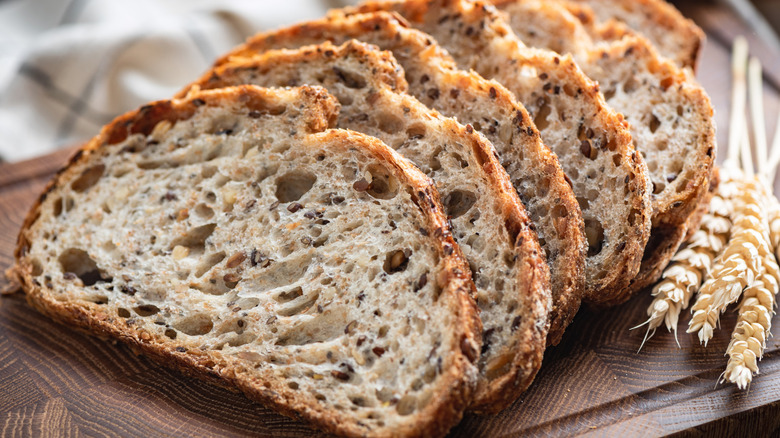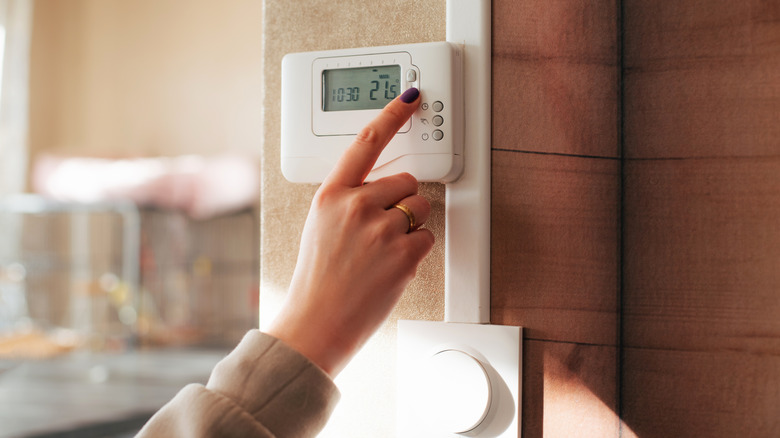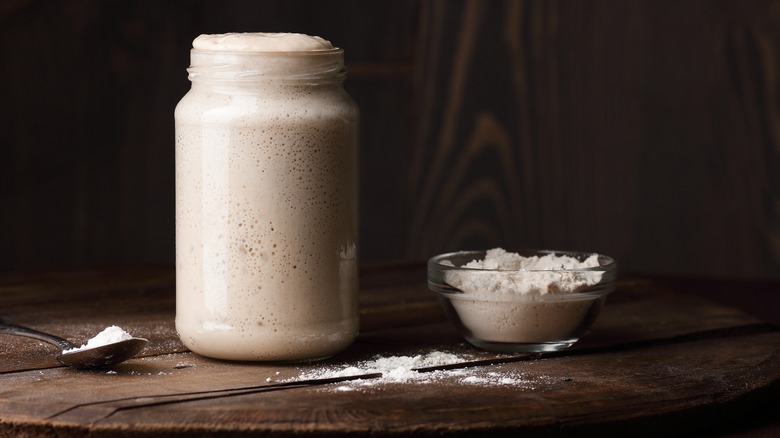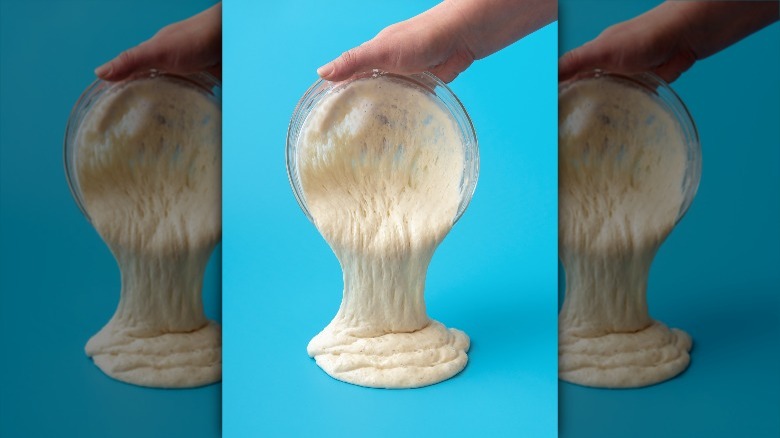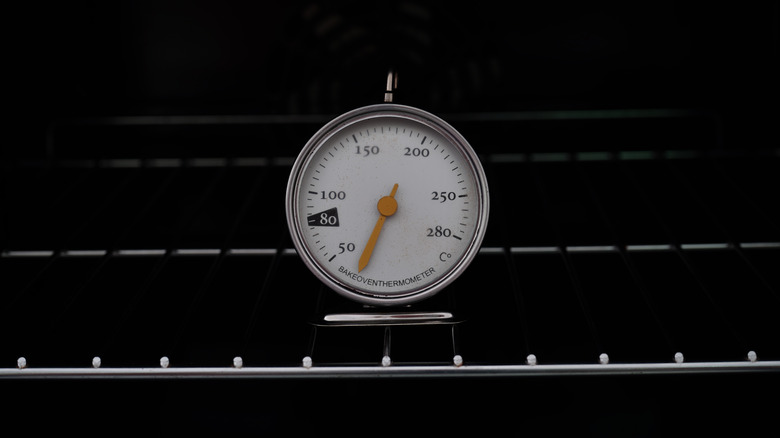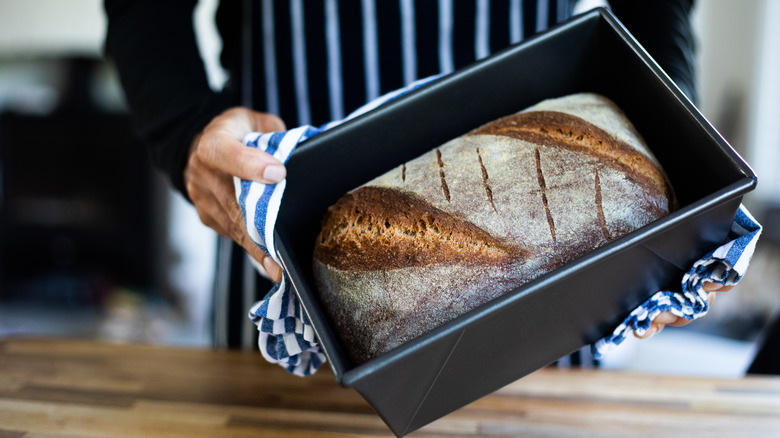5 Little Mistakes That Make Or Break Your Sourdough
Bakers in ancient Egypt may have been the first to make sourdough, but the bread didn't get its name until 19th-century miners in San Francisco finally noticed, after all those millennia, "Hey, this dough tastes sour!" Baking sourdough, or at least watching other people bake it, was all the rage back during the pandemic, but it's been staging a recent comeback on TikTok. (If 2020 nostalgia's ever going to be a thing, you know that's where it'll start.) Whether you've been working to perfect your sourdough baking since the lockdown or are just starting out now, a few tips and tricks from a pro surely won't come amiss. In order to acquire some, Mashed spoke with Nathan Myhrvold of Modernist Cuisine and he generously shared his advice.
Myrvhold spilled the flour on all things sourdough, supplying all manner of helpful hints. Most importantly, he pointed out what not to do if you want to make sure your loaf is a success. From nurturing that all-important starter up to putting the loaf in the oven, here are his top five mistakes to avoid when baking sourdough bread. (We'd like to add an unofficial sixth one: As long as it tastes good, don't worry what it looks like. The world already has a zillion and six sourdough pics, so surely social media will survive without adding a few more.)
Not keeping an eye on the thermostat
According to Nathan Myhrvold, temperature fluctuations affect the starter's pH level, which in turn affects acidity. Maintaining a consistent temperature is important, which means keeping the starter away from drafts. You could also store the sourdough starter in the refrigerator if you're taking a break from baking, but don't keep it in cold storage if you're planning on using it soon since cold temperatures slow the fermentation way down. The opposite, however, is also true.
As Myhrvold tells us, "The higher the ambient temperature, the faster the rate of fermentation," and notes that this can result in the starter being more acidic if the weather is hot or you keep the heat cranked up. "A starter can actually starve if it's too hot," he says, so you may need to feed your starter more in hotter weather in order to avoid committing doughicide. (From there, it's but one small step to cereal killer.)
Myhrvold says some bakers feed once a day in winter and twice in summer, but he feels this method can be too imprecise. If you don't want to perform complicated calculations regarding the feeding schedule and amounts, he advises: "The best option is to find a way to keep the temperature consistent" as long as your heating and cooling system is sufficient to keep the kitchen at the same temperature in July as it is in January. Of course, you could also just pick one season for sourdough baking and stick with it.
Overfeeding the starter
Yet another factor that affects the acidity of the sourdough starter is how frequently you feed it. If you feed it less often, it will become more acidic. The acidity level will also rise the longer you wait to use your starter, counting from the time you last fed it. If you feed the starter more frequently, however, this will have the effect of lowering the acidity. In fact, Nathan Myhrvold cautions, "If you feed it too frequently, you can dilute the starter so much that it will lose its leavening power and acidity."
The more acidic the starter, the more "sour" your sourdough will be, which stands to reason. Still, as Myhrvold points out, "There is no right or wrong level of acidity; it's a matter of personal preference." This means you may have to do some experimenting, both to find your preferred level of sourness and the feeding schedule that gets you there. Still, if you mess up and make a starter that's too sour for your liking, Myhrvold says all is not lost. In this case, you can simply use less of it and add a smidgen of yeast (between 0.3% and 0.4% of the mixture) to the bread dough.
Sticking with a bad starter
Everyone knows that the heart of sourdough is the starter, and whether you've purchased yours or made it from scratch, you might become pretty fond of it after all those feedings. Nathan Myhrvold admits, "A starter is a living, breathing thing," but it's not a pet, so he says you shouldn't go into mourning if it dies. Even if you've carefully fed and monitored the temperature and taken the best possible care of your dough baby, the fact is, sometimes starters can just start smelling funky or acting flat and lifeless. At that point, it's time to let them go.
If you do need to abandon your starter, numerous other cooks feel your pain, Myhrvold among them. As he explains, this experience "can be distressing to many bakers who can get very attached to the starters they've taken the time to build." Still, as he reminds us, a sourdough starter "isn't magic, it's just flour and water." He adds, "You can always start a new one. Flour and water are cheap."
Forgetting the oven thermometer
Okay, so you and your thermometer have managed to survive the early stages and make it to the point where you've got an actual oven-ready loaf. Congratulations, but don't break out the bubbly too soon. The bread's not going to bake itself — it'll need some help from you, and Nathan Myhrvold says one piece of equipment is crucial (besides the oven and the pan, of course): an oven thermometer. The reason why you shouldn't try to rely on the oven temperature gauge alone, he explains, is because "The temperature control in a typical home oven is not very good." Besides, as he notes, "Oven thermometers are inexpensive," so there's no point in letting all your hard work go to waste when you can just run out to Walmart and buy one for under 10 bucks.
If you've got change left over from your oven thermometer purchase, you might want to drop a few more bucks on a cheap kitchen timer, too. As Myhrvold reminds us, "Bread bakes quite quickly," with some recipes calling for less than 30 minutes of oven time (our sourdough biscuits are done in 20). For this reason, he says, "You want to be vigilant and pay attention to the bake time of the recipe you're using" and a timer will help you do just that.
Checking on your bread too soon
Some bakers like to shape their sourdough in loaf pans, some go with dutch ovens or cast-iron frying pans, while others use baking bowls or go freeform with sheet pans. Nathan Myhrvold doesn't weigh in on this issue, but he does say that whatever vessel you favor, you need to ensure that it stays hot before, during, and after you add the dough. For the before part, this means preheating, so you'll let the dough rise on one pan, then shift it to the heated one before it cooks. In order to prevent heat loss once the loaf's in the oven, though, this means no peeking — at least not to begin with.
As Myhrvold explains, "It's critical that you don't open the pot to look at the bread for the first 5 to 10 minutes, which is when the crust is really forming." Once you're past that point, which may be about a third of the way through the baking process, the crust should be pretty much set. "After that," Myhrvold says, "it's okay to check on your bread; you're not going to harm it."
